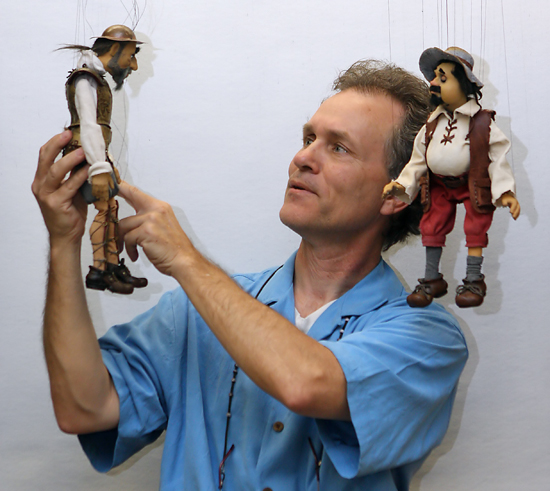Inside a tie-dyed drawstring bag hangs a 12-inch version of one of literature’s most complex characters, Don Quixote. This mini-Don is a marionette that belongs to UCLA animation instructor and master puppeteer Steven Ritz-Barr, who has re-told the classic story through puppets in his latest film, “Quixote.”
The film will screen at the James Bridges Theater on Friday. It is the second of the “Classics in Miniature” series, the first being a re-telling of “Faust,” another famous literary character with complex psychological motivations.
These are the types of stories Ritz-Barr is most interested in exploring.
For him, the contrast between the medium of puppets, typically thought of as a juvenile way to tell a story, and the adult themes of the story and the larger-than-life characters provides for an interesting contrast and intense visual experience.
“Everyone knows a puppet isn’t really a person,” Ritz-Barr said. “He doesn’t really exist. This is just a bunch of wood and strings, but if you really believe it, it’s really strong. It’s an intense experience to look at if it’s done well.”
Actor Michael York, who voiced Don Quixote, was charmed by the idea of using puppets to tell the classic story.
And while Ritz-Barr said that it’s not a children’s film, York said that he was attracted by its approachable style.
“It’s not an academic take on it ““ there’s something very appealing about this very heroic man,” York said.
Written in the early 1600s, the story of Don Quixote is still constantly recognized by literary critics as one of the greatest works of fiction ever, and the deluded, adventurous spirit of the title character is one that anyone can relate to even today.
History Professor Teo Ruiz, who assigns “Don Quixote” as reading for his class on Imperial Spain, said that despite the difficulties his students encounter in terms of the book’s rambling style, the story itself is timeless.
“What (Miguel de) Cervantes does is really address questions of the human condition,” Ruiz said. “How do we define ourselves? By virtue or by descent or by wealth? How do we satisfy our greatest needs in order to relate to others? It is a wonderful story about the power of dreams and the death of dreams.”
The greatest difficulty for Ritz-Barr was condensing the lengthy story into a half-hour long film. He had read the book years ago for pleasure, but as he began work on the screenplay, it was hard to isolate the rambling story into a handful of instances that would please Quixote-philes and make sense thematically. But he also wanted to do something new, and with the physical constraints of using puppets, he didn’t really have a choice.
“I had to take liberties the book didn’t have,” Ritz-Barr said. “These are string puppets, and there’s a lot of things they can’t do.”
Before delving into the world of puppeteering, Ritz-Barr originally studied acting and spent several years preparing for the ministry.
But in a theater class on puppeteering, Ritz-Barr found that he liked how he could infuse a physical object with theatricality and character without the ego of an actor getting in the way.
He lost interest in pursuing a life in the ministry and turned his attention to solely studying puppetry.
“I found that these (puppets) were my little gods,” Ritz-Barr said. “These were things you could project whatever you wanted onto.”
Over the next 30 years, Ritz-Barr studied puppetry in Indonesia, France and under Muppet creator Jim Henson.
He has worked on a number of major films, including “Team America: World Police” and “Men in Black.” Now, he has two of his “Classics in Miniature” films completed with plans for a half-dozen more.
He’s currently in the early stages of development for a film about Joan of Arc, a character who, like Don Quixote, is motivated by psychological underpinnings to confront massive challenges.
“These are characters that are larger than normal life,” Ritz-Barr said. “Projecting it with a puppet works very well.”
